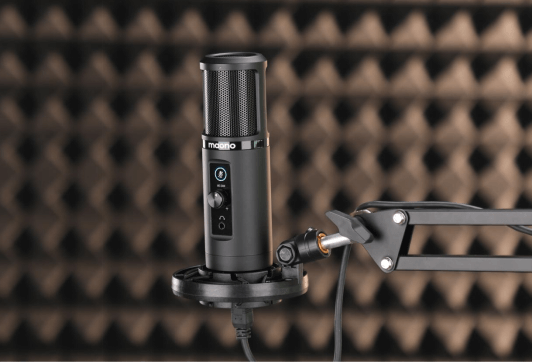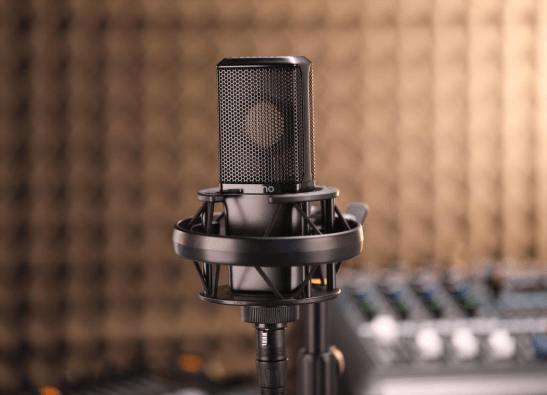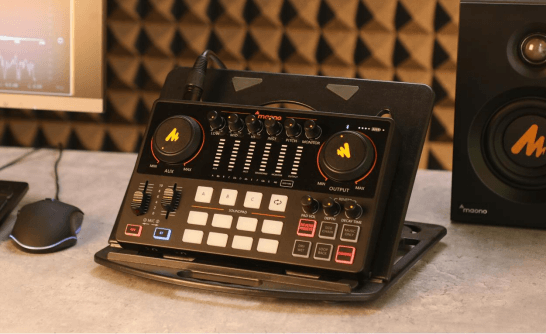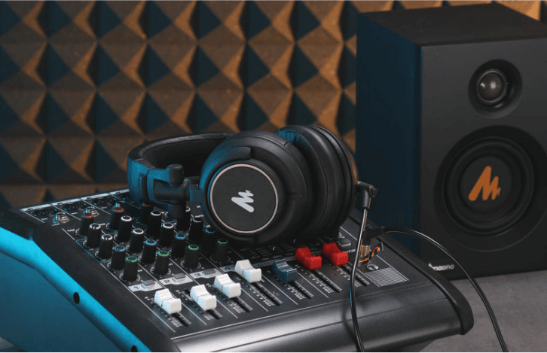An online radio station is a radio that is streamed over the internet, which means that an internet connection is required to tune in. With the evolution of technology over the past 10 years or so, listening to (and creating) content online has become increasingly popular. If you’ve ever thought of how to start an online radio station, this guide will show you how to bring your dream to life. Setting up an online radio broadcasting setup is easier than ever, and we’ll break down the steps for you.
How Can I Start a Radio Station? Essential Steps to Get Started
Step#1 Create a concept for your content that differentiates your radio station from the others
The first thing you’ll need to do when starting an online radio station is to find a concept. To differentiate your radio from the thousands of others out there, you must choose a theme or genre. Not only will this help define your radio project, but it will also make it easier for you to decide what you would like to broadcast on your station.
Once you have chosen the concept of your radio station, it’s time to decide what type of content you want to broadcast. Will you create a 100% musical radio station? A talk radio station? Or a mix of both?
Don’t forget that if you’re planning on broadcasting music on your radio, you will need to obtain the necessary licensing to comply with copyright laws. The best option is to contact your local music authorities to get all the necessary information.
Step#2 Create a Brand Identity
Creating an identity for your radio station is also an essential step. When thinking of a name for your radio, remember to keep it short and sweet! The name should reflect the concept of your radio and should be easy to pronounce and remember.
Your identity also includes the logo of your radio station. Again, it’s important to include a visual element that conveys the concept of your station. Your logo should include no more than 3 colors and should include the name of your radio.
Step#3 Determine your Target Audience
When starting your radio project, you need to define a target audience. Who is your radio station aimed at? Having a clear idea of who will be listening to your radio will help you adapt your tone and content to please that specific audience.
Step#4 Choose your Radio hosting service
A radio hosting service provides radio broadcasters with online streaming servers. This is, essentially, what allows you to broadcast your audio to the internet. You start by sending the audio from your computer to a dedicated radio server provided by your hosting service. This audio is then sent out via different media connected to the Internet such as a listening link, a website, a mobile application, a connected car, and even connected speakers!
Many hosting services, such as RadioKing, also provide additional features to help manage and share your radio station. These additional features may include various widgets, such as a radio player, to help you give easy listening access to your audience.
Equipment You Need to Start Your Own Radio Station
When setting up your online radio broadcasting setup, the right tools make all the difference. You’ll need a reliable computer, microphone, mixing desk or audio interface, and headphones. Along with this, choosing the best software for online radio is critical to managing your broadcasts effectively. Beginners can start by checking essential radio broadcasting equipment for beginners to ensure smooth, professional-quality audio output.
-
Tip #1: Get the right internet radio station equipment
The equipment you need to start an online radio station will depend on the type of content you wish to broadcast (live or automatic), as well as your budget. But don’t worry, there’s no need to break the bank to get what you need to start broadcasting! If you’re mindful of expenses, it’s smart to calculate the cost to start an online radio station early on, including hosting, gear, and software costs.
-
Tip#2: You need a Computer & Internet connection
The only equipment you need to start your radio station is a computer and an internet connection. Most computers and laptops made in the last 7 years are more than capable of doing the job!
When it comes to choosing your operating system (Windows, MacOS…), your choice will largely depend on which live broadcasting software you want to use. Some software, such as Mixxx or VirtualDJ, is compatible with both Windows & MacOS.
-
Tip#3: Choose the Right Microphone
If you’re planning on broadcasting live on your radio station, we suggest that you invest in a microphone to ensure good audio quality. There are many different types of microphones available, today we’re going to distinguish XLR and USB mics. Some of the best microphones for radio hosts include options like the Maono PM422 USB and PM500 XLR microphones, offering excellent clarity for speech-heavy broadcasts and long-form interviews.
USB Microphone: the Maono PM422 USB Microphone is a great choice for beginners with a cardioid polar pattern, meaning it will focus on your voice and ignore background noises. You can easily connect the mic to your computer thanks to the USB output. It includes a wide range of essential features such as a built-in professional sound process chipset, a one-touch panel mute button, and a flexible gain knob. This particular model has a sample rate of up to 192kHz/ 24bit, as well as a 3.5mm headphone jack for zero-latency monitoring.

XLR Microphone: this type of microphone requires an audio interface or mixing desk to connect to your computer. The Maono PM500 XLR Microphone is a sturdy solution that’s built to last, with zinc alloy and multilayer coatings. It acts as an electromagnetic shield to provide a crystal-clear audio signal. Benefit from a dynamic range of 20Hz - 20KHz thanks to a custom-designed 34mm gold spluttered condenser capsule.

The circuit design is made from high-quality components and a custom-made permalloy audio signal transformer which provides low self-noise and remarkable sound capturing for all your audio needs.
-
Tip#4: Get a Reliable Mixing desk or audio interface: The Maono AME2
As mentioned before, if you opt for an XLR microphone, you will need an audio interface or mixing desk to connect it to your computer. These devices also allow you to use more than one audio input, such as multiple microphones or a smartphone.

The Maonocaster AME2 Integrated Audio Production Studio has built-in high-quality pre-amps and also includes phantom power, necessary for condenser mics. It provides up to 11 customized sound pads to enhance your broadcasts, as well as a 32Bit high-performance chipset and DENOISE function that reduces any noise or grain. There are many great features to enhance your recordings, such as 6 reverb modes, 12-step auto-tune, 3 modifiable tones (treble, mid-range, bass), and even pitch changer knobs.
Plus, it’s compatible with most devices such as PCs, smartphones, tablets, cameras, Windows, Mac OS, etc.
-
Tip#5: Grab a MH601 Headphone
Headphones are the last piece of essential equipment for your radio broadcasting needs. You may feel a bit lost when searching for the perfect pair, as thousands of different models exist.

The MAONO MH601 headphone set is an excellent choice, as they have protein leather memory foam for maximum comfort, a 1.50mm driver for deep bass, vivid mids & stereo, and a 3.5/6.35mm jack. They are also extremely convenient and lightweight, folding up to 90° in both directions.
Choosing the Right Streaming Platform:
Alongside equipment, software matters. Consider features like live streaming, analytics, and monetization. Understanding the cost to start an online radio station also helps you plan realistically. Expenses can range from $500 to $5,000+, depending on software, licensing, and hardware.
If your goal is to earn from your station, explore how to monetize online radio station options such as ads, sponsorships, or listener subscriptions. Many platforms now offer built-in monetization features, making it easier for beginners to generate revenue.
1. Understand Your Needs
Consider your goals. Are you aiming for live broadcasts, pre-recorded content, or a mix? Platforms like Shoutcast and Icecast are ideal for internet radio, offering flexible streaming options.
2. Check Features
Look for features such as:
- Live streaming capability
- Listener analytics to track audience engagement
- Monetization options like ads or subscriptions
3. Compatibility
Ensure the platform supports the audio formats you plan to use (e.g., MP3 or AAC) and integrates well with your broadcasting software.
4. Cost and Scalability
Start with free or affordable options, such as Mixlr or Zeno.fm, if you're a beginner. Choose scalable platforms as your audience grows.
5. Licensing and Compliance
When starting an online radio station, it's essential to comply with legal requirements and licensing procedures to avoid copyright infringement and ensure lawful broadcasting. You must research radio station license requirements in your country, as these determine whether you can legally play copyrighted music or use public frequencies.
Music Licensing: Obtain licenses from performance rights organizations (PROs) like ASCAP, BMI, or SESAC (in the U.S.) or their counterparts in your region. These licenses allow you to legally stream copyrighted music.
6. FM vs Internet Broadcasting
If you’re unsure which direction to take, you can follow an FM vs internet radio setup guide to compare the benefits of both. FM radio remains ideal for local audiences and community stations, while internet radio gives you global reach and flexibility, often with lower costs. Many creators now combine both for maximum exposure and diverse audience engagement.
Tips for Growing an Audience for Your Radio Station:
Here’s some quick tips to help you grow your audience:
-
Define Your Niche
Focus on a specific genre or theme (e.g., indie music, talk shows, or sports commentary). A clear niche attracts loyal listeners. -
Promote on Social Media
Create profiles on platforms like Facebook, Instagram, and Twitter to engage with your audience. Share upcoming show schedules, highlights, and listener shoutouts. - Engage with Listeners
- Host live Q&A sessions.
- Encourage listeners to send song requests or messages.
- Run giveaways or contests to boost engagement.
-
Collaborate
Partner with local artists, podcasters, or influencers to expand your reach and bring fresh content to your station. -
Consistency is Key
Stick to a regular broadcast schedule to build listener habits. Consistency fosters trust and keeps your audience coming back. -
Leverage SEO
Create a website or blog with optimized content about your station. Use keywords like “internet radio” and “online radio station” to attract organic traffic. -
Analyze and Adapt
Use listener analytics to identify trends. Adjust your content and schedule based on audience preferences.
Choosing the right platform and implementing growth strategies can help you create a thriving radio station with a dedicated audience.
Best Internet Radio Station Software 2025
Starting an online station in 2025 is easier than ever, thanks to advanced broadcasting platforms that combine reliability with user-friendly tools. Choosing the best software for online radio depends on your goals—whether it’s live broadcasting, automated playlists, or audience engagement.
Top picks for 2025 include RadioBOSS, known for automation and scheduling, SAM Broadcaster for professional-grade features, and Mixxx, a free open-source option ideal for beginners. Cloud-based platforms like Radio.co and Live365 also stand out, offering simple setup, licensing assistance, and streaming stability.
Each option balances ease of use, affordability, and pro-level tools, making it easier for creators to launch and scale their internet radio stations successfully.
FAQs:
How much does it cost to start a radio station?
The cost of starting a radio station can vary widely but typically ranges from $500 to $5,000 or more, depending on factors like equipment, software, and licensing fees.
Can I start a radio station without a license?
No, you generally need a license to broadcast legally, even for an online radio station. Licensing fees depend on the country and broadcasting rights.
When starting an online radio station, it's essential to comply with legal requirements and licensing procedures to avoid copyright infringement and ensure lawful broadcasting. Here's what you need to know:
-
Music Licensing: Obtain licenses from performance rights organizations (PROs) like ASCAP, BMI, or SESAC (in the U.S.) or their counterparts in your region. These licenses allow you to legally stream copyrighted music.
-
Copyright Compliance: If you're broadcasting music, ensure you have proper agreements for using copyrighted material. This may also include paying royalties to artists and copyright holders.
-
Broadcasting Software Compliance: Use licensed streaming software or platforms to avoid violations related to software piracy.
-
Station Name Registration: Choose and register a unique station name or trademark to protect your brand legally.
-
Regional Regulations: Research local or regional broadcasting laws, as some countries may require additional permits or adherence to specific guidelines for online radio stations.
Following these steps ensures that your radio station operates within the legal framework, minimizing risks and protecting your business.
Can I start my own radio station from home?
With the right equipment, such as a microphone, audio interface, and broadcasting software, along with a reliable internet connection, yes you can easily start your own radio station from home. Platforms like Shoutcast or Icecast allow you to stream your content to a global audience right from the comfort of your home.
What software do I need to start a radio station?
To start a radio station, you'll need broadcasting software like Sam Broadcaster, Radio.co, or OBS Studio, along with audio editing software like Audacity for creating and managing content.
Do I need a license?
Yes, if you plan to stream copyrighted music on your online radio station, you’ll need a broadcasting license to cover royalties for artists, songwriters, and record labels. If your station only features royalty-free or original content, a license may not be required.
How much does licensing cost?
Licensing costs vary by country and the type of music played. In the U.S., fees from organizations like ASCAP, BMI, and SESAC can range from $300 to $1,000+ per year depending on audience size and usage. Platforms like Live365 include licensing in their subscription, making it easier for beginners.
Can I start a radio station with zero budget?
Starting with absolutely zero budget is challenging, but you can begin small using free tools and platforms. Many online radio hosting services offer free trials, and you can use free software like OBS Studio or Mixxx to broadcast from your computer. As your audience grows, consider upgrading to paid hosting or better equipment for improved quality and reliability.
What software handles radio broadcasting?
Popular radio broadcasting software includes Mixxx, BUTT (Broadcast Using This Tool), RadioDJ, and SAM Broadcaster. These programs let you manage playlists, automate broadcasts, and stream live to online radio servers. Choose one based on your technical comfort and the features you need.
Is FM broadcasting still relevant or should I go internet-only?
FM broadcasting remains relevant for local audiences and communities with limited internet access. However, internet radio offers a global reach, easier setup, and lower costs. Many new broadcasters start online, while established stations combine both FM and online platforms for maximum exposure.
Conclusion:
As we’ve seen, to start your own radio, you need to come up with an original idea that will differentiate you from other stations. Once you understand the radio station license requirements and have your radio broadcasting equipment for beginners ready, you’re prepared to go live. Whether you prefer the traditional FM route or a global online setup using our FM vs internet radio setup guide, investing in the best microphones for radio hosts ensures your sound remains clear and professional.
So, are you ready to start your own radio station? Check out Maono's premium podcasting equipment today!"



